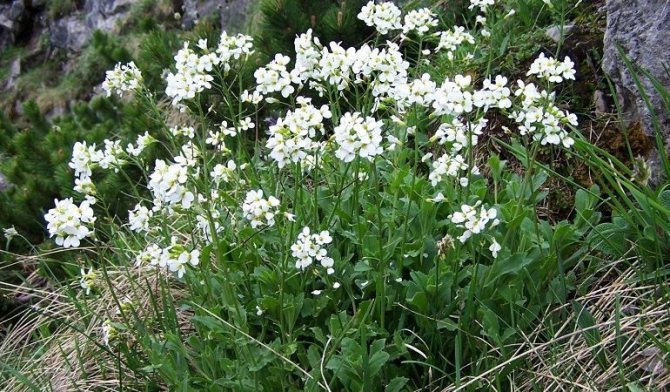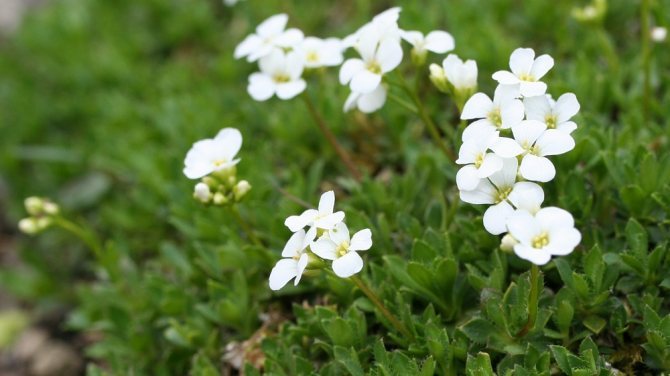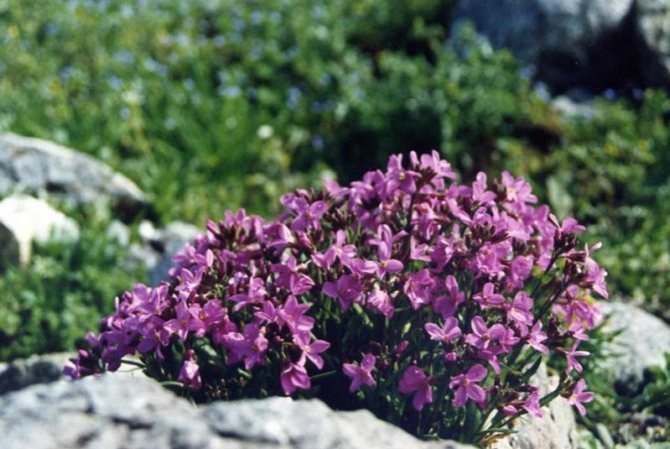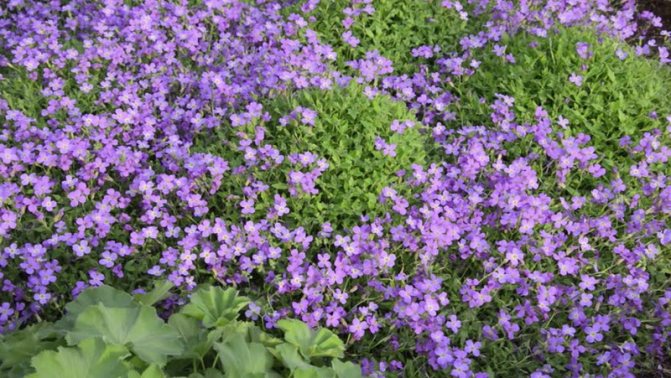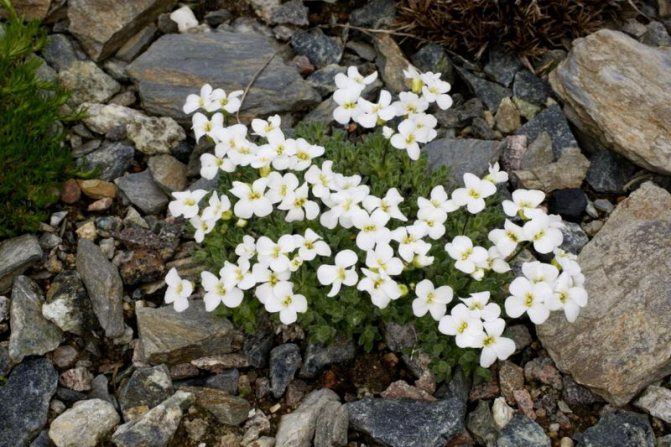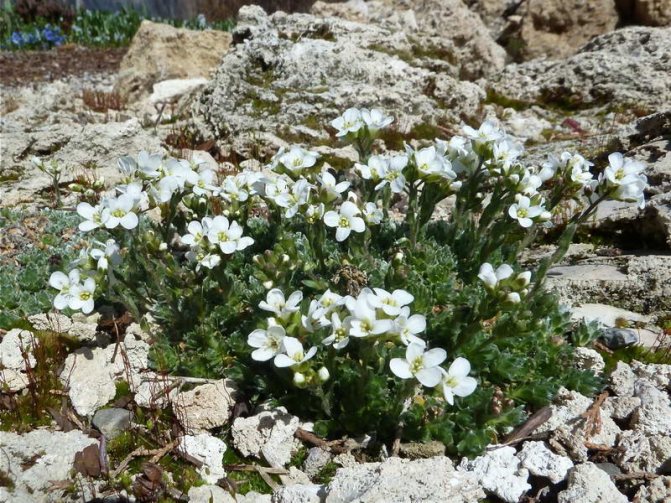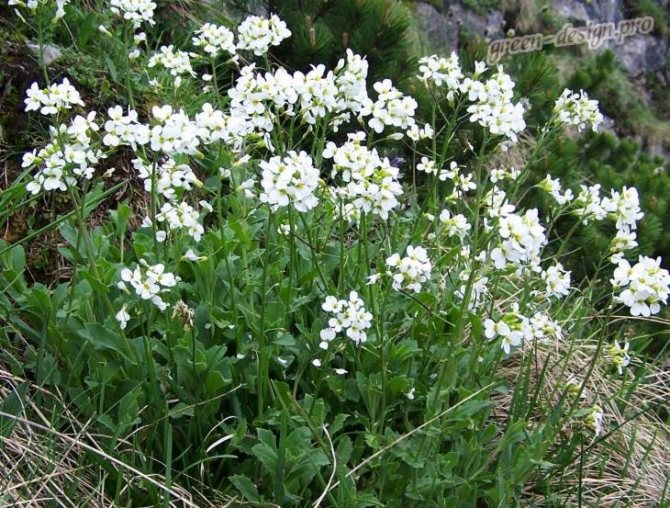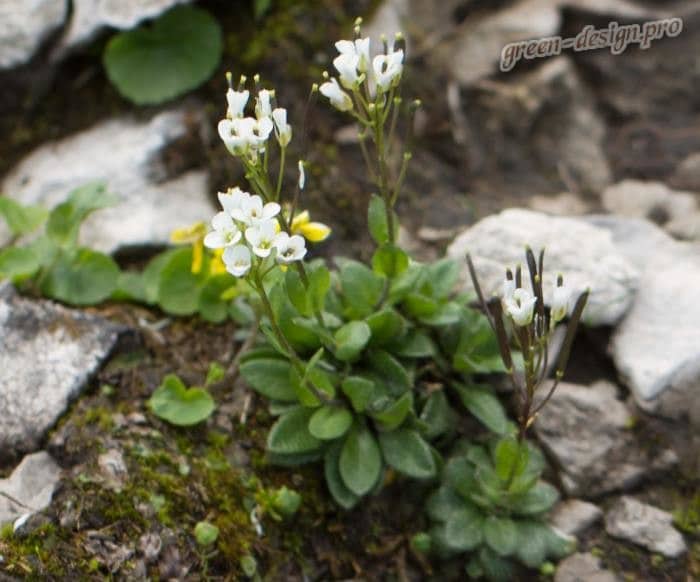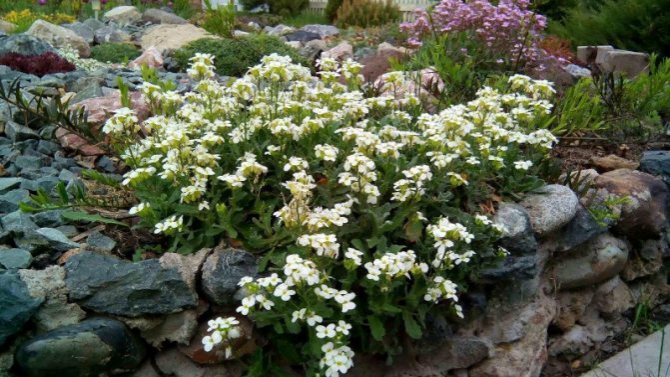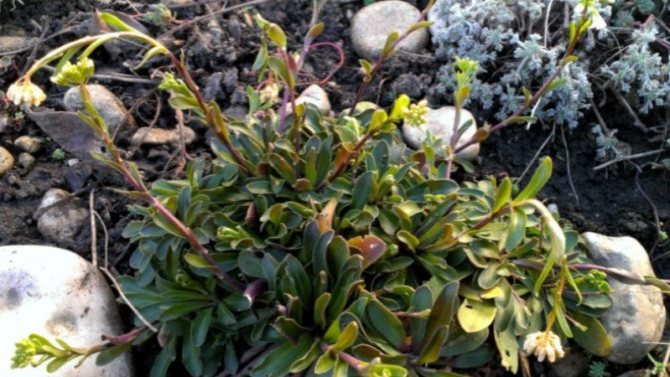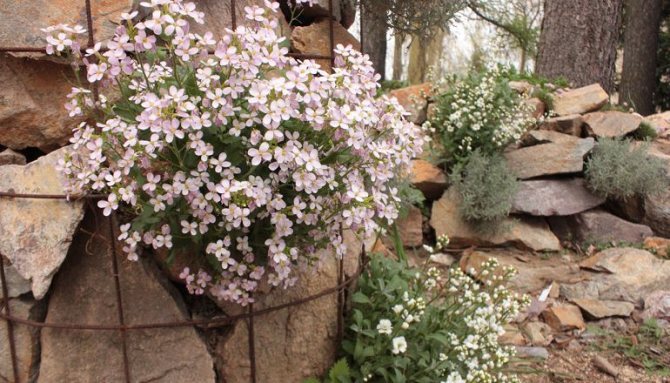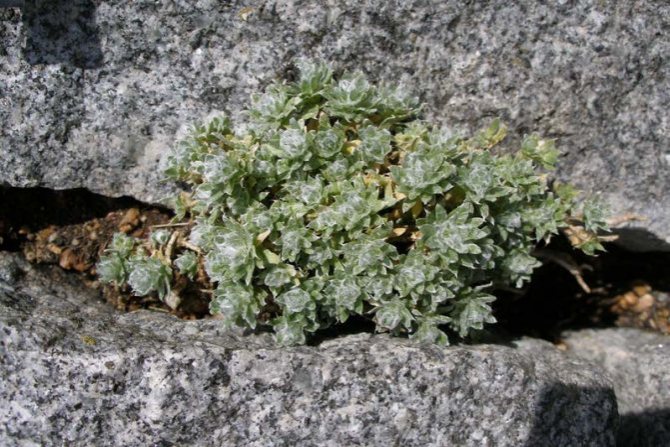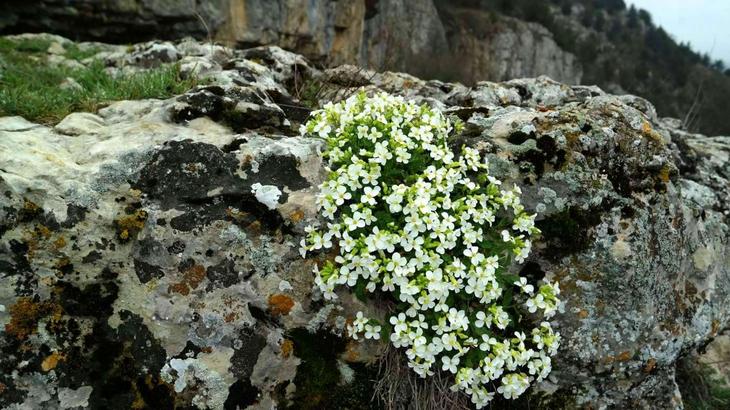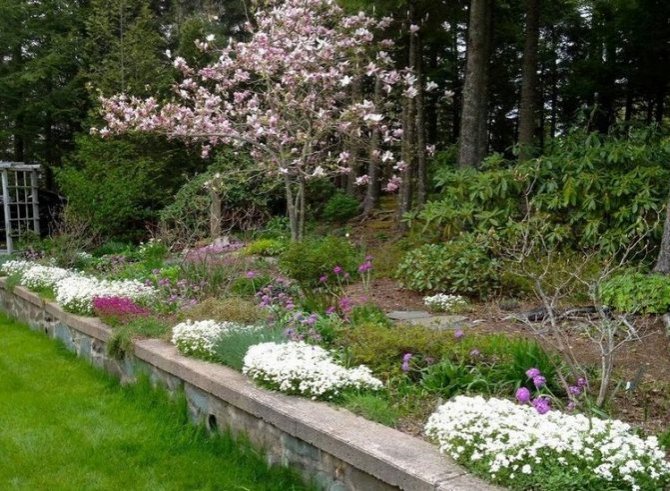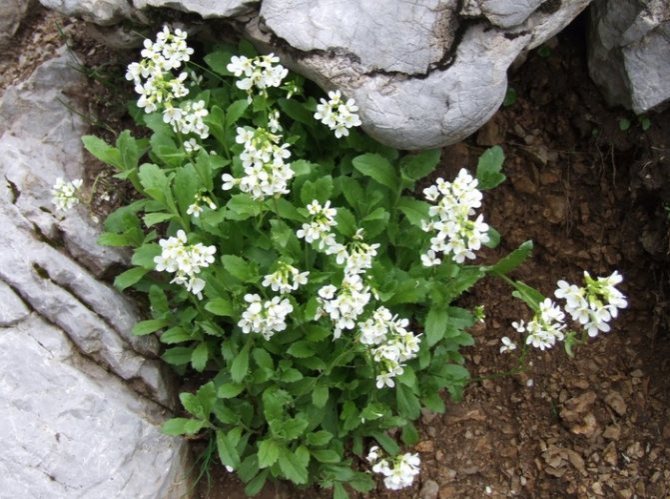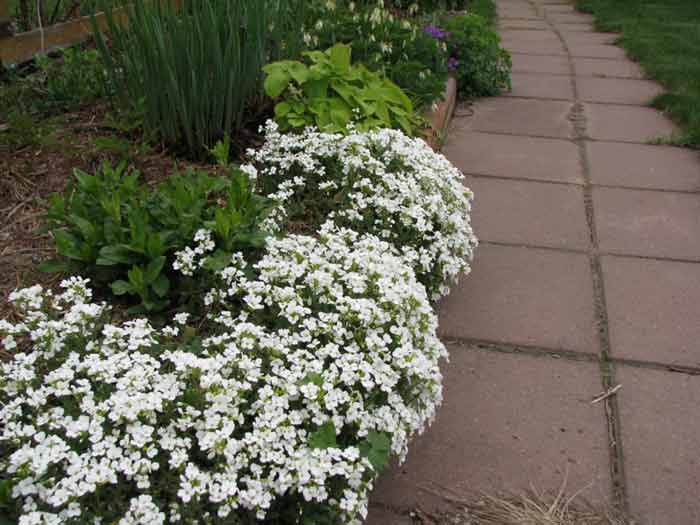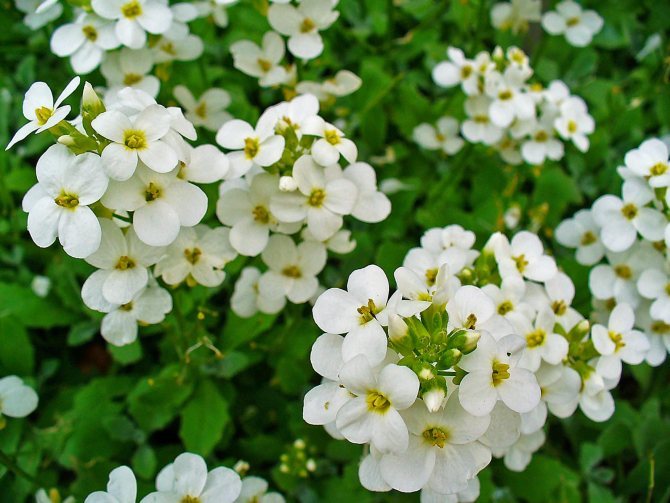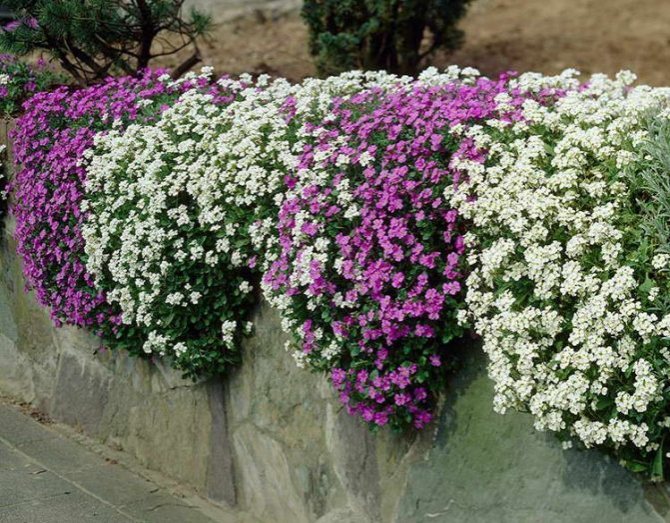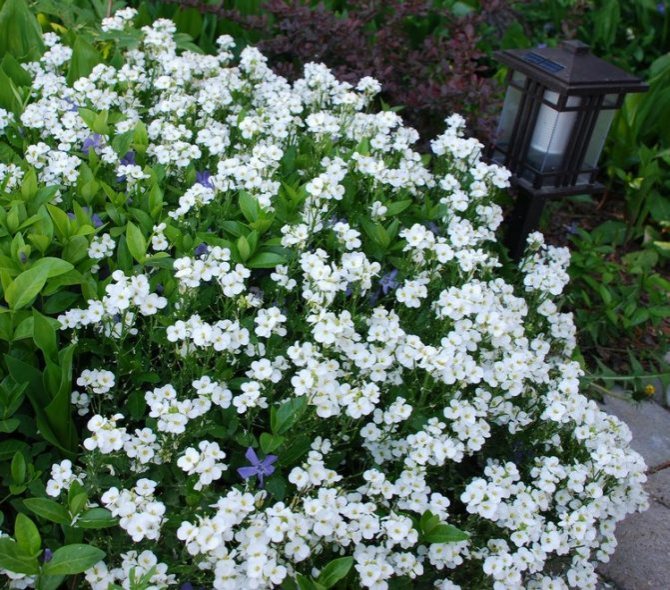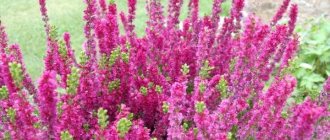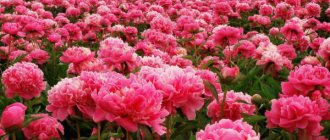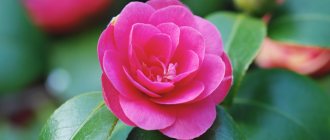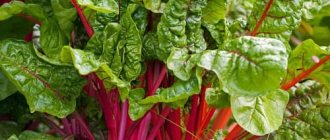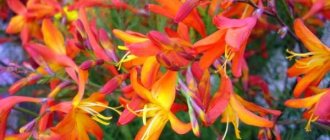Summer residents who want their site without much hassle to wrap a lush flower blanket every spring will certainly fall in love with perennial Arabis - planting and caring for it, in the open field, does not require special skills and knowledge. These perennial plants have not only a decorative exterior, but also a pleasant aroma, and reproduction takes place quite quickly.
Popular species and varieties
Among all the variety of varieties of arabis, the following have an integral leadership:
- Caucasian - characterized by increased resistance to soil poverty, drought and excess moisture, temperature extremes and severe frosts. The bush barely reaches 15 cm in height, but it can grow into a dense flowering canvas that covers almost any surface. The root system fills in any crevices, masking some of the shortcomings made in the construction or cultivation of the land.
- Alpine is one of the most fragrant types of Arabis, on the basis of which many hybrid varieties have been created. Flowering begins in mid-April - abundant, with the release of many tassels of white and pink shades. The height reaches 20 cm.
- Bryophyte - has the longest flowering, up to 30-40 days. Flowers are both ordinary and double, shades vary from white to bright lemon.
Preparing the landing site
Planting and caring for perennial Caucasian Arabis begins with choosing a suitable place.
Important!
The landing site you choose should have good lighting. If you plant Arabis where there is poor lighting, then it will have significantly fewer flowers.

It is advisable to find a place on a hill, since there will definitely not be stagnation of water, because of which the roots of the rezuha can rot. It will also be a big plus if the soil is non-acidic and rich in nutrients. But, again, we note that even in unfavorable conditions, Arabis will delight you with beautiful flowering.
When a suitable place is found, you can start preparing the soil. First of all, you need to dig out the roots of perennial weeds from the soil, as they can interfere with the growth of Arabis. Immediately before planting the crusher, it is worth adding sand, crushed stone, chalk or dolomite flour to the holes. Another important point: the holes should be at least 30 cm apart.
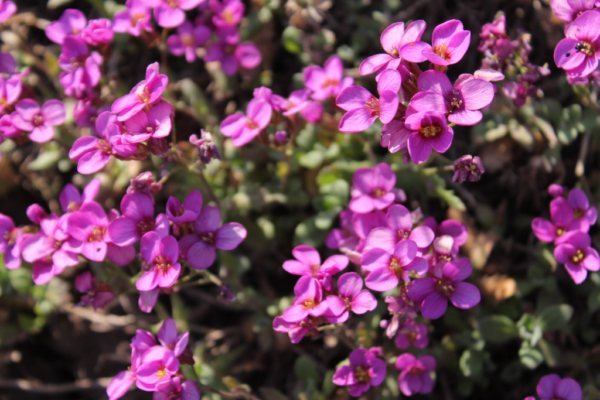

If you nevertheless planted Arabis in the place where water stagnates, then be sure to drain it.
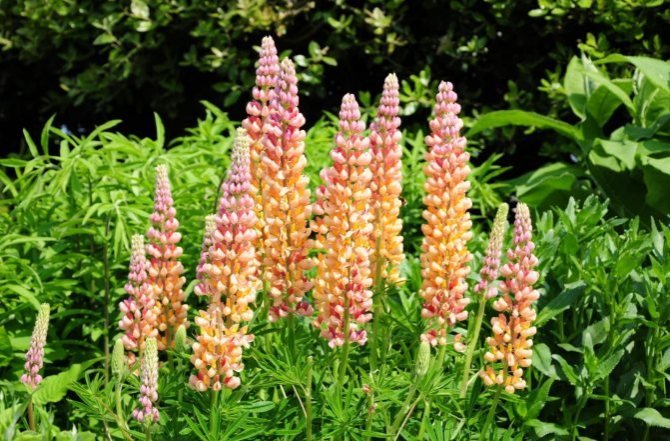

You may be interested in:
Perennial lupine: planting and care Have you ever traveled out of the city from Moscow along the M4 highway in mid-May? A few kilometers after the Moscow Ring Road ... Read more ...
Description
Arabis is often called rezuha. Belongs to the cruciferous family, which include cabbage and radish. An evergreen herbaceous groundcover that can grow in a short time. It has small stems, reaching a height of no more than 30 cm. Plants may not be erect, but lie on the ground.


Under natural conditions, it grows mainly in areas with a temperate climate, and is also able to live among the African sands.
- Leaves. Green with a grayish tinge due to the villi. Alternately arranged on short petioles. The shape of the leaf plate is different.
- Flowers.Many varieties of various colors have been bred, with 4 petals, collected in a brush. Flowering begins early, around the end of April, and lasts a month. With proper pruning and removal of faded bolls, it is possible to reapply it closer to autumn. Today arabis has a double shape. Perennial flowers are like small roses. In order for rainbow hats to remain in our memory for a long time, they do the landing and the necessary care during the landing.
- Fruit. The seeds are small, collected in a pod.
- Roots. The root system consists of numerous roots that do not penetrate deeply into the ground.
Interesting!
Among the rezu there are ephemerals that can survive in the desert until spring comes and the rainy season comes.
Description and photo
Arabis (also called rezuha) is a small-flowered, profusely blooming evergreen perennial reaching a height of 25-30 cm.


Today, there are up to 200 varieties that have both a wide range of colors and a delicate, refined aroma. Early and long flowering rightfully allows us to call it the leader among herbaceous flowers used for garden design.
Watering and feeding
There is nothing complicated here either. The regularity of watering the Arabis depends on the weather: in hot and dry weather, it is worth watering the rezu much more often than in cloudy and rainy weather. During the growing season, Arabis is also watered as needed.


As for fertilizing, it is enough to apply fertilizers once a year (in spring). Humus or compost can be used as top dressing. Before flowering, the plant can also be fed with complex mineral fertilizers.
The use of a plant in landscape design
Florists love Arabis for its delicate airy bloom and accommodating disposition. The flower feels great both in small garden beds and in spacious multi-species compositions. The plant successfully decorates curbs, rockeries or low fences, hides the problem areas of the site with lush flowering.
Arabis is ideal for alpine slides and all kinds of hilly plantations due to its mountainous origin.
In the photo, an alpine slide with alpine arabis:
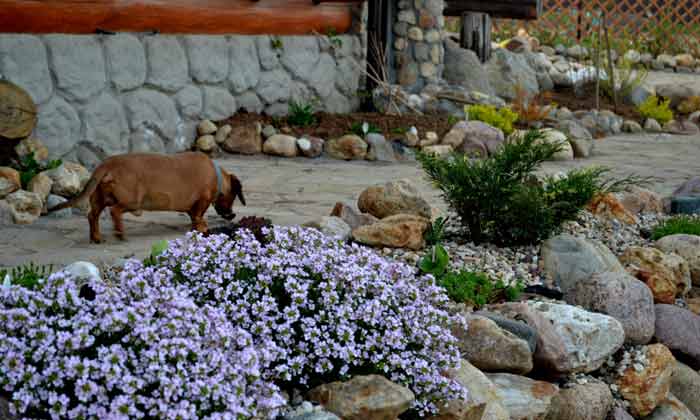

Rezuha on an alpine slide


When planting it in the spring, you should wait for flowers only next year. Therefore, it is better to plant a bright annual plant next to it. In a few years, the alpine rezuha will cover the entire free area in the composition.
Arabis loves light, it is better to place it in an open area, away from trees and bushes. Planted at the top of a hill, it will give abundant bright blooms and a fragrant aroma.
In flower beds, Arabis behaves like an intractable neighbor. It can quickly displace nearby growing plants. It is better to plant it with alissum or roses, it successfully decorates the area under shrubs and trees.
Landing in open ground
Before disembarking, you should study the rules and recommendations.
When to plant
It is recommended to plant arabis in open ground in late May or early June. An important condition is the presence of at least three formed leaf plates in the seedlings.


Seat selection
Well-ventilated areas with sufficient sunlight are suitable for planting perennial arabis. Planting is allowed in a shaded area, but in this case, you should not expect abundant growth and flowering.
Soil requirements
This flower prefers a nutritious soil with good drainage properties and does not tolerate drought well. The optimum soil temperature is +20 ° C. Loose sandy, moderately moist soil, previously cleared of weeds, is ideal for Arabis. The addition of a small amount of turf, sand and small stones helps to improve the moisture and air permeability of the soil.
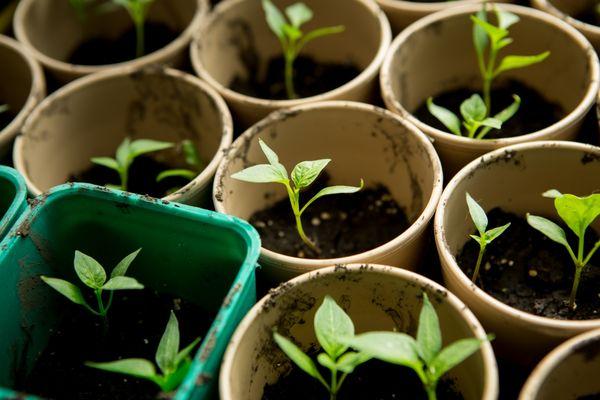

Poor sour and calcified soil is not very favorable for Arabis. In it, the plant does not fade, but grows too weakly.
Landing scheme
The optimal arrangement of seedlings is 40 x 40 centimeters. Thus, the Arabis bushes will grow well without conflicting with each other. To get the effect of a thick carpet of flowers, you need to place 3-4 seedlings in one hole. Depending on the subspecies and weather conditions, flowering can begin as early as late summer or next year.


How to plant Arabis in the ground
For Arabis, you need to choose the right place so that the plant will please with flowering and grow well.
Arabis develops best in open sunny areas that are well blown by the wind. You can, of course, plant a plant in a shady area, but then the bush will not be so lush, and the flowering is scarce and short-lived.
The soil for planting Arabis on the site should be dry, loose and light. It is pre-dug up with organic and mineral fertilizers, cleaned of weeds. Sand is added to heavy soils during digging.
During planting, about 40 cm is left between the plants. To get a dense carpet, 2-3 seedlings are planted in one hole. After planting, Arabis is well watered.
Important! If fertilizers were not applied for digging, then after a few days the seedlings can be fed.
Loading ...
Arabis grown from seeds will bloom only in the second year.
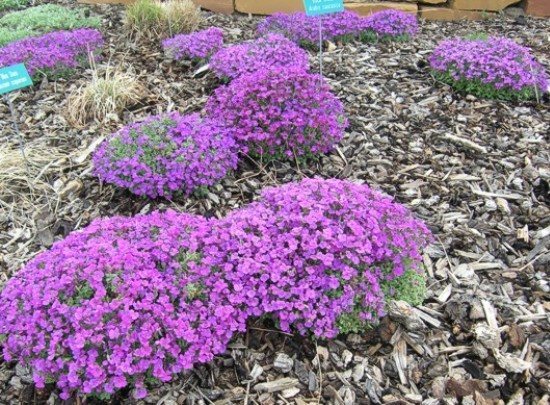

Plant care after flowering
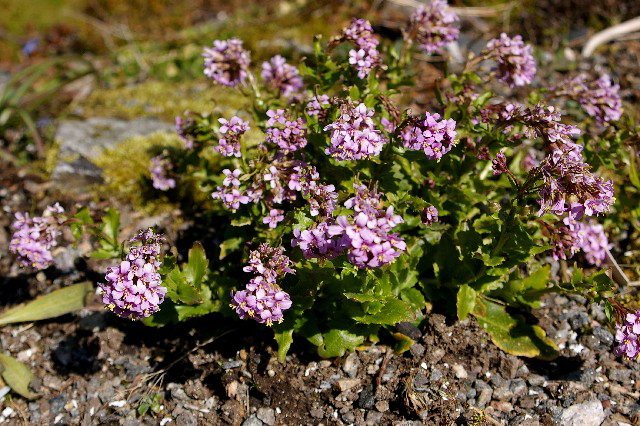

Arabis cultivation
Even when Arabis blooms, the grower should note the most powerful inflorescences from which to collect seeds. When the first frosts pass, they are harvested in dry weather. If the seed is harvested at the wrong time, it may not germinate well the next year. The inflorescences, together with the stem, are cut off and allowed to dry out already indoors, hanging in dry, ventilated places. When the workpiece is dry, seeds are removed from it, which are placed in a cardboard box and stored until the time of sowing.
Arabis wintering
This plant survives only in light frosts - about -5-7 ºC. To ensure its survival even in more severe weather, the stems of Arabis are almost completely cut off, leaving only 3-4 cm, and the roots are covered with leaves, grass, spruce branches, and other materials that protect from severe frosts.
Diseases and pests
Having dealt with planting and caring for perennial terry Arabis, you need to talk in detail about diseases and pests, since they can significantly interfere with the growth of these beautiful flowers.
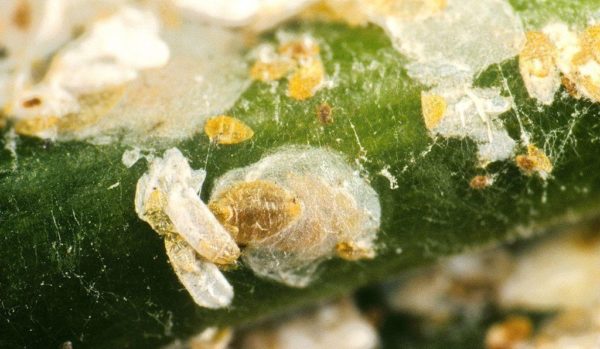

Let's talk about pests first. Arabis does not have so many of them:
- Shellfish. Holes in the leaves indicate their presence on the plant. Most often, mollusks appear on those plants that grow in areas with excess moisture.
- Caterpillars. These pests feed on the pulp of leaves and flowers, as well as shoots. Timely loosening and mulching of the soil, as well as periodic weeding and watering, will help get rid of them.
- Cruciferous fleas. Most often, they attack young plants, and it is in September-October. You can get rid of them only with the help of insecticidal drugs, such as karbofos or aktara.
And also the pests of Arabis include snails and slugs. You can only get rid of them manually, and it is almost impossible to prevent their occurrence.
Arabis is extremely resistant to various diseases, but there is one disease that even this plant cannot resist. This disease is called "viral mosaic". This disease is evidenced by the appearance of bright yellow flowers, similar to buttercups. The viral mosaic is not cured, therefore, if it affects your Arabis, then it will have to be dug up and burned.
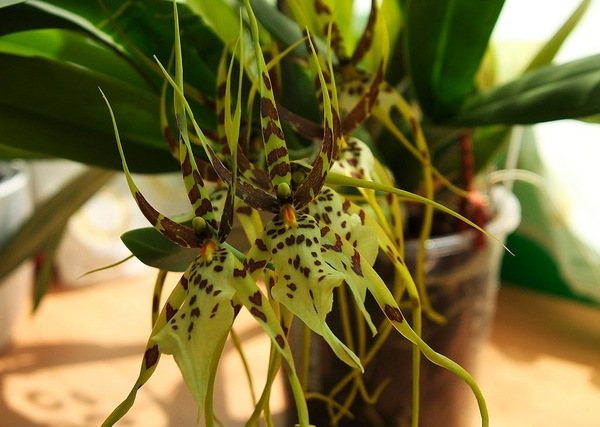

You may be interested in:
Care Tips for the Unusual Brassia Orchid Brassia orchid is one of the most popular house flowers. It is difficult to care for, but extraordinarily beautiful in bloom ... Read more ...
Care
The main stages of caring for Arabis are the implementation of regular watering, weeding and loosening. Watering is done as needed, avoiding stagnant water. In conditions of sufficient precipitation, it can be stopped.
Top dressing begins from the moment of planting in open ground - using specialized complex mineral compositions for flowering crops and succulents.
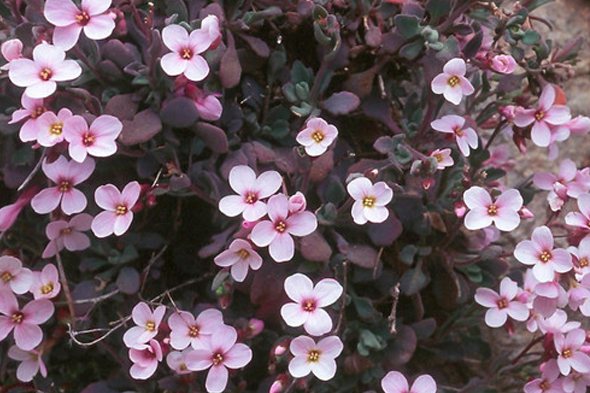

Pruning a plant promotes more active growth of side shoots and, accordingly, a more dense formation of the grassy canvas.
Pests and diseases
Since arabis is a natural inhabitant of mountainous areas, cultivated varieties also have a high level of resistance to attacks by well-known garden insects.
A good preventive measure against garden aphids and midges is to sprinkle the area around the stem with fine ash.
Of the diseases that a plant can be exposed to - fungal lesions that develop due to non-compliance with planting conditions, among which are excessive thickening and stagnation of excess water. When the root system decays, the flower withers, stops its growth and may die, therefore, if an annoying sign is detected, transplantation should be made to a more suitable place that has additional drainage and protection from the accumulation of water.
Preparing for winter
With the onset of autumn frosts, pruning and watering should be stopped. Evergreen Arabis winters well in cold but snowy winters. If the low autumn temperatures exceed -10 degrees, and the snow cover has not yet formed, you should take care of an artificial shelter, which can be seared foliage, ripe sawdust and garden covering material.
It should be remembered that the artificial turf must be removed in spring in order to avoid burning the shoots under the spring sun.
Tags: alpine slideevergreen perennialneutral soilsoilcover
Reproduction
There are several breeding methods for perennial Arabis. For these purposes, you can use seeds, cuttings and some other options.
Seeds
Perennial Arabis seeds are prepared in April. Planting boxes must be filled with a substrate made from garden soil and sand in a ratio of 3: 1. Seeds should be sown 0.5 cm deep. The optimum air temperature in the room is +20 ° С. After sowing the seeds, the box must be covered with glass. The soil must be moistened and ventilated for at least half an hour every day.
After the development of 2-3 leaves, the seedlings need to be transplanted into separate pots and grown before planting in open soil.


Reproduction of Arabis
There are several breeding methods, we will consider everything.
Seminal
Since when buying, you can choose hybrid varieties that have the best varietal characteristics and are not damaged by diseases.


The conditions are as follows:
- The time interval for planting is selected based on when it is necessary to obtain flowering. When planted in spring, flowering will come the next year, in autumn - the plants will bloom only after overwintering. For earlier flowering, containers are prepared in February, which are disinfected with any antibacterial agent. You can use what is in the first aid kit. Dilute potassium permanganate, hydrogen peroxide, ammonia.
- For the soil mixture, take 3 parts of garden soil and one part of sand.
- Room temperature promotes good growth and survival of seedlings.
- Disembarkation is done by half a centimeter.
- After planting, the soil is sprayed and covered with a transparent material or agrotextile.
- Plantings are inspected daily. If the humidity is too high, it is necessary to ventilate the mini greenhouse.
- A pick is carried out when 3 leaves are formed.
- The soil is loosened about once a week to make it easier for the Arabis to break through.Do this carefully, you can use sushi sticks.
- Well-developed seedlings are sent to flower beds.
Seed propagation is a laborious process, but for the same amount you can get many bushes grown from seeds or just one purchased from a store by seedlings.
Cuttings
You may be interested in: Do-it-yourself water well drilling: rules and features of drilling Do-it-yourself fish pond: step-by-step construction technology with photos Types of metal furniture: features and rules of operation
You can cut the stems to obtain cuttings constantly throughout the season.
If they are germinated in the ground, then planting does not differ from seed reproduction. The only difference is that parts of the stems are planted obliquely, without burying deep.
The easiest way is to take a glass, bucket or vase, fill it with water and add a root formation stimulator, such as Kornevin, to it. Put the twigs. After a while, they will give roots.
If an Arabis standing in a glass has thrown off its leaves, this does not mean that he died, so the rizuha can defend itself. Wait a little more, young leaves should appear on it. Better inspect the stem. If it starts to dry, then the cuttings have failed.
Division of bushes
Ground cover plants reproduce well in divisions, as they are able to creep, filling everything around. This is facilitated by a horizontal root system.
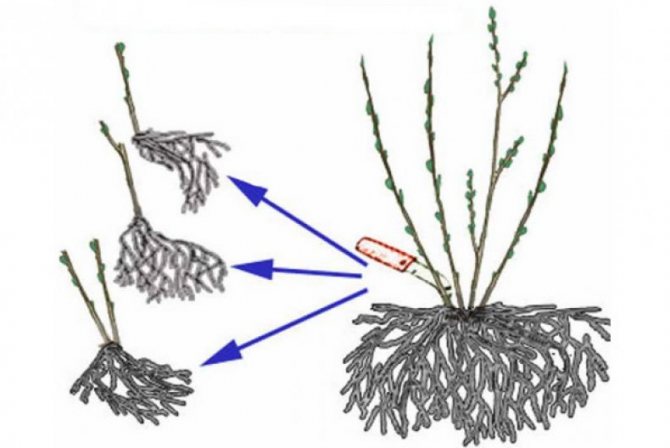

For this method, you need to dig up the plant from the side, take a sharp knife and separate part of the root with it. Treat the cut with ash and plant the finished bush in a new place.
Arabis transplant
Sometimes perennial Arabis needs to be transplanted to another place, then, in addition to the question of leaving and planting, the question arises of how to transplant the rezuha. By the way, the photo below shows a variety of Arabis called "Snow Cloud".


So, with regard to transplanting, it is important to remember that Arabis has very thin roots that are easily damaged, so it is better to transplant using the transshipment method. Here are detailed instructions for transplanting this plant:
- We prepare wells in advance with a depth of no more than 25 cm.
- Before transplanting, water the soil so that the soil is sufficiently moist.
- We loosen the soil next to the Arabis and carefully pull it out along with the earth from its original place.
- We transplant the razuha into a new hole.
- We fill the plant with soil and compact it a little.
- Water the plant again.
Growing seedlings
One of the simplest and most reliable methods of growing perennial Arabis is to prepare seedlings from quality seeds, which are readily available at garden centers or specialist shops.


Timing
Seeds for seedlings should be sown in April, using special containers or boxes filled with a substrate with a balanced composition.
Soil preparation
The growth and development of Arabis seedlings depends on properly prepared soil. The optimal composition is a mixture of three parts of garden soil and one part of river sand (it can be replaced with small pebbles).
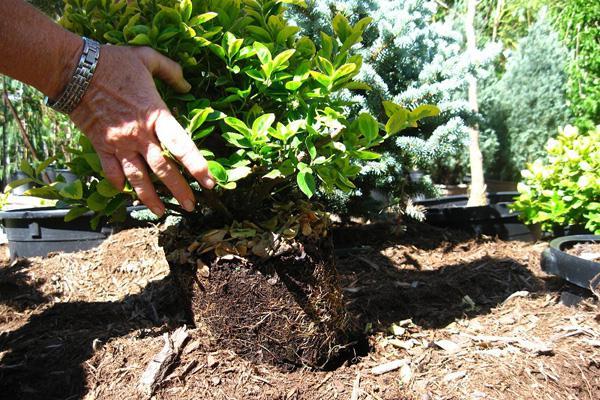

How to plant
The seeds must be placed in the prepared substrate to a depth of 0.5 centimeters. The air temperature in the room where the containers with seedlings will be located should not exceed +20 ° С. To accelerate the emergence of seedlings, cover the containers with agrospan or another type of non-woven fabric.
Watering
Water the seedlings only when the soil requires moisture. Frequent irrigation is not required, but the condition of the soil should be monitored regularly.
Loosening
The topsoil with seedlings should have a loose and light structure, so it needs daily loosening with a small rake or a regular fork.


Picking
When the first leaf plates appear in seedlings, a pick is required. To do this, you need to distribute them in separate cups or transplant them at a distance of at least 30 centimeters from each other.
This procedure is only necessary if you plan to grow a flower separately. In the case of growing arabis as a ground cover plant, picking is not carried out.
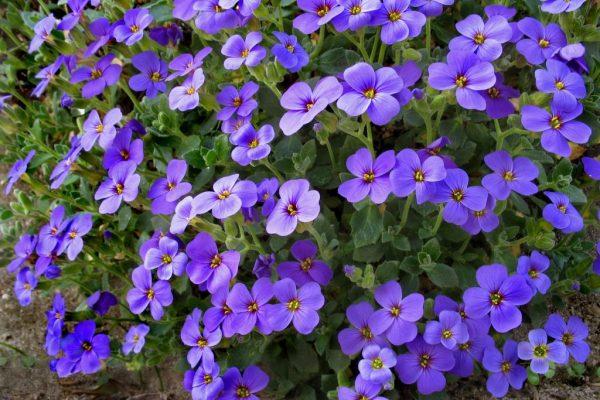

Hardening
The hardening of the plant should be started 10-12 days before planting in an open area. In order for Arabis to adapt well to new conditions, it must be taken outside daily, gradually increasing the duration of its stay in the fresh air. In this case, it is necessary to provide seedlings with reliable protection from drafts.
Perennial Arabis is a wonderful decoration of the garden
An undemanding plant is very popular with florists, landscape designers and all those who love to grow garden flowers and make their summer cottage attractive. For more than 2 centuries, Arabis has been used to add brightness and style to alpine slides, rocky gardens, rabatkas, and simply planted along garden paths. Everywhere it looks equally elegant.
Botanical description
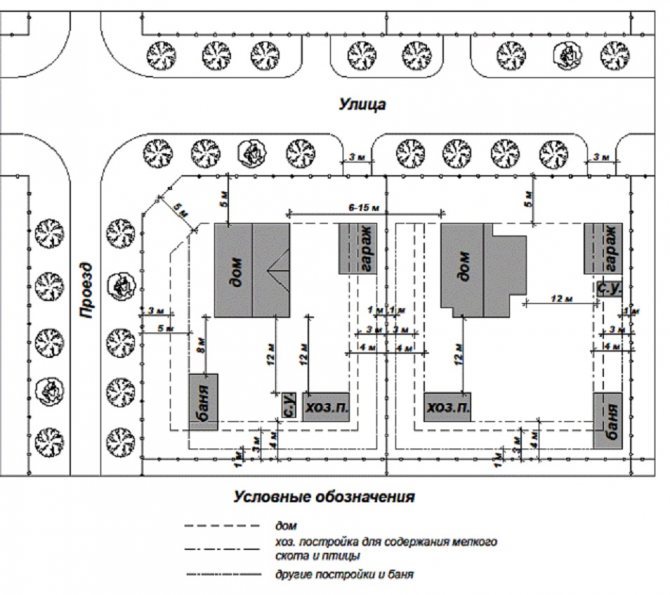

- Arabis or Rezukha is attributed to perennials and herbaceous plants of the Cruciferous (Cabbage) family. In the world today, about 200 species of this undemanding undersized plant are known.
- The work of breeders bears fruit: among these species, half are bred hybrids, interesting in their structure and characteristics.
- In the wild, Arabis can be found in the northern part of America, in regions with a temperate climate, in the highlands of Eurasia, on rocky slopes, as well as in the tropical part of mountainous Africa. Loves Arabis and sandy terrain.
- This is a wonderful honey plant, therefore insects constantly fly near the fragrant fragrant bushes. The second name was given by the people due to the presence of hairs of pubescence, which have a rigid structure. The appearance of the Latin name remains a mystery to this day.
- Flowers can be grown as annuals and perennials. These are ground cover plants with a small root system and a height of only 30 - 35 cm. The structure of the stems is creeping, and they can take root.
- The bush is richly decorated with bright green foliage. The surface of the leaf plate has dense pubescence, the leaves are whole, their shape is in the form of a heart. Some species have a jagged edge.
- During the flowering period, the bush is covered with small brush-shaped inflorescences, consisting of small flowers no more than one and a half centimeters in diameter. Their color is limited to 4 basic colors: yellow, pink, white, purple. The structure of the flower can be simple and double.
- Flowering begins in the second half of April. Usually it is abundant and lush, the whole bush is covered with inflorescences, around which bees fly.
- After the flowering phase, the fruit ripens in the form of a pod, in which the seeds of a flat shape are located. Some varieties of arabis are winged.
Popular varieties
Below are some of the most popular varieties that can be offered to grow in central Russia. They are undemanding and decorative, with simple beauty and appeal.
Caucasian
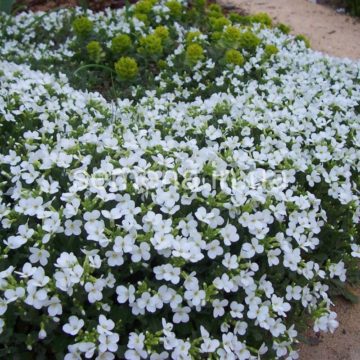

- The root system is very well developed, adapted for growth and development in mountainous areas, suitable for growing in rocky gardens.
- The variety is able to root very quickly in the most inaccessible rocky crevices. In height it reaches no more than 15 - 17 cm, but in width it spreads like a "carpet" by almost half a meter.
- The peak of flowering occurs in May. In blooming state it looks very delicate against the background of dense green foliage. This arabis, like many varieties, has a pleasant and strong enough aroma. Flowers can be milky white or light pink.
Ciliated
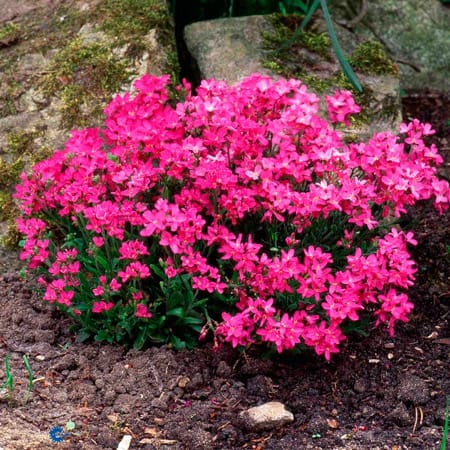

- In the wild, it can be found in the highlands of California, at an altitude of half a kilometer. The height is very small - only 8 cm, the bush is compact, the structure is ground cover. The plant spreads on the ground, and perfectly withstands the scorching sun and drought.
- It is a perennial, the crown circumference is about 25 - 30 cm, the foliage is dark green with a grayish tint, and the flowers have a bright pinkish - crimson color.
- In flower beds and in flower beds, several varieties are most popular: Route Sense and Frühlingshaber.
Alpine


- The area of growth is very large: it lives high in the mountains in the north of America and in Europe, and also occurs in the Urals, the Far East. The species is one of the tallest - shoots reach 30 - 35 cm.
- The sprouts are strong, highly branched, forming a "pillow". The species has several types of shoots: some rush upward - generative, the second - in the form of lashes, spread. The result is a very lush, symmetrical, well-formed bush.
- The flowers are white or light pink, with a circumference of about a centimeter, collected in racemose inflorescences 5 cm long. The leaves growing at the base of the bush are oval in shape, on the stems - arrow-shaped - heart-shaped.
- The peak of flowering is in the second decade of April, flowering continues for a rather long time - almost a month. The flowers exude a pleasant aroma.
- Notable varieties: Schneeshaube, pink and white garden forms.
Also known are the following types: Bruovidny, Runaway, Stunted, Prolomnikovy, Ferdinand Coburg Variegat. You can buy seeds of several types of arabis at once, and make a wonderful ensemble, diluting with other garden plants. How to grow it correctly, see below.
5. Reproduction
There are many ways to propagate Arabis and they are all easy. The choice of a particular method will depend on the species and varietal characteristics of the flower.
Species plants can be safely propagated by seeds - the daughter bushes obtained in this way will exactly match the appearance of the parents.
Varietal plants during seed propagation lose their attractiveness and declared characteristics - they are propagated by any vegetative method - division, air layering, stem and leaf cuttings.
Terry varieties do not form seeds at all after flowering.
↑ Up,
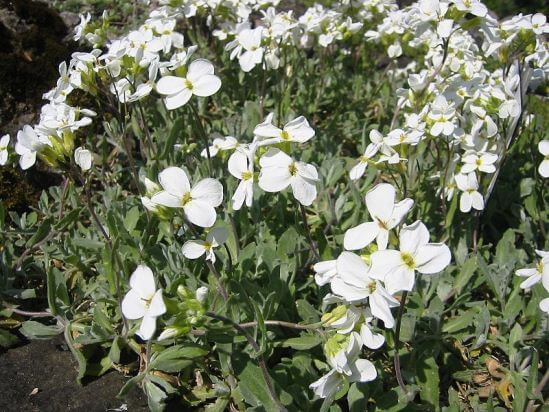

5.1 Growing from seeds
Sowing seeds is carried out both directly into the open ground, before winter, and at home in early April - for seedlings.
When sowing in winter, it is worth choosing the timing so that the first shoots do not have time to appear before the onset of frost. Seedlings usually appear amicably.
↑ Up,
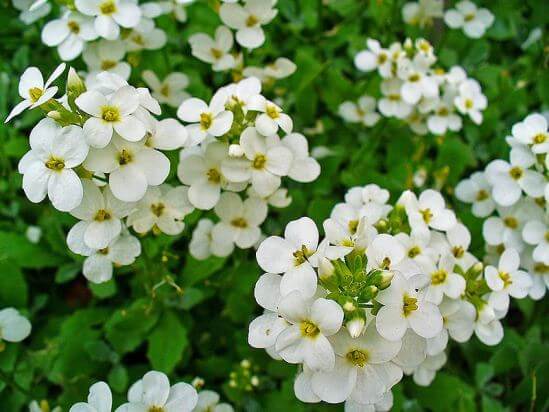

5.1.1 Collecting seeds
In order to obtain planting material with good germination, it is necessary to allow the pods to fully ripen on the plants. For collection, the largest and most brightly colored flowers are outlined.
So that the pods do not spontaneously open and do not throw the seeds on the ground, they are wrapped in advance with gauze or bandage. They try to gather on fine, warm days.
The collected seeds are dried for several hours in a warm and well-ventilated place by spreading them out on sheets of paper. After drying, the seeds are folded into paper bags, stored and used as needed for 1 to 2 years.
↑ Up,
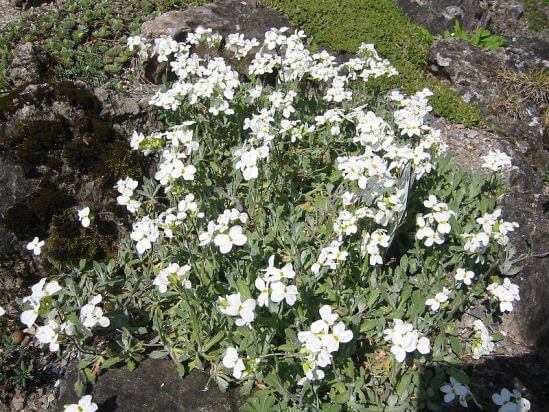

5.1.2. Sowing seeds
When sowing seedlings for growing Arabis, special seedling boxes with transparent lids are taken, and they are made on their non-drainage holes. Drainage is put in the first layer, and then the rest of the volume is filled with nutritious and loose soil 1/3 consisting of river sand.
Seeds are sown evenly over the surface of the substrate and covered with a layer of earth about 5 mm thick from above.
From above, the boxes are closed with lids or tightened with non-woven material and placed in a fairly cool place with a temperature of about 18 degrees. The location should be brightly lit but out of direct sunlight.
↑ Up,


The shelter is removed daily for ventilation, gradually increasing the time. With the appearance of the first shoots, the shelter is completely removed.
The soil in the boxes is kept evenly moist, but not waterlogged, by spraying water from a spray bottle.
With the appearance of the first 1 - 2 true leaves, the plants dive - they are seated in hotel cups or pots. The dive is carried out as carefully as possible, trying not to pick up the bushes together with a lump of earth and not injure long roots.
7 - 10 days after the dive, the plants can be fed for the first time with nitrogen fertilizers in a very low concentration.
↑ Up,
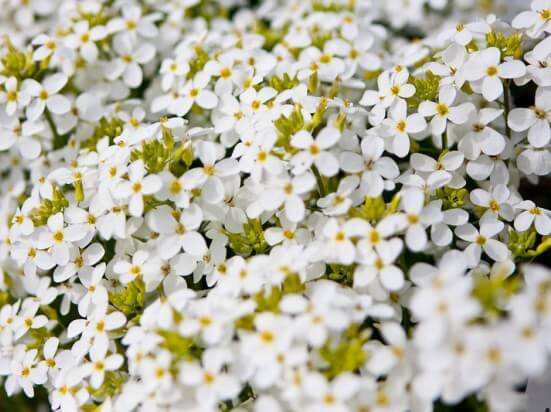

5.2 Propagation by cuttings
Since many terry varieties do not form seeds, and in order to fully preserve the varietal characteristics of plants, they use vegetative propagation methods, including cuttings.
Arabis is cut with leafy or stem cuttings.
↑ Up,
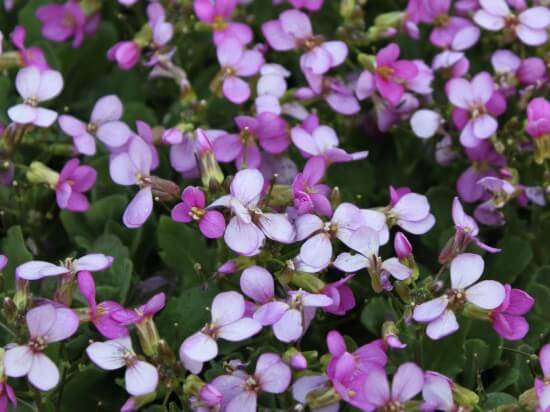

5.2.1 Leafy cuttings
Leaf cuttings should not be removed with scissors. but you should certainly tear it off with your hands, slightly pulling the sheet down. With this method of separation, a small heel remains at the base of the petiole - the cambial layer on the outside of the shoot.
For rooting, use small flower pots filled with nutritious potting soil. The leaf stalk is immersed in the soil only a few millimeters and the substrate is kept evenly moist.
After some time, young growth can be seen at the base of the leaf.
↑ Up,
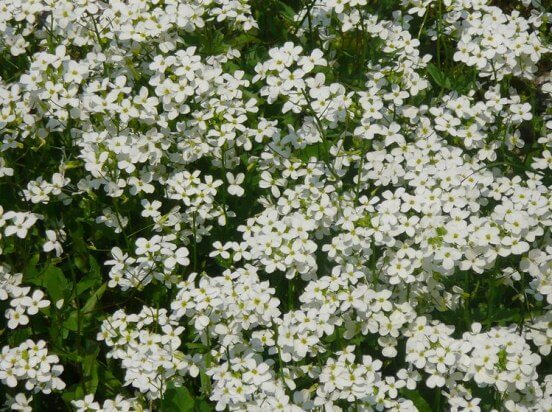

5.2.2. Stem cuttings
Another method of grafting is the use of stem cuttings - such cuttings are cut after flowering so that their length is 8 - 10 cm.
The lower leaves are removed to reduce moisture loss and the base is powdered with growth hormones. The cuttings are immersed in a moist substrate about 1 cm deep at a slight angle.
The pots are covered on top with a transparent plastic bag or glass to create a greenhouse effect and maintain high humidity.
↑ Up,
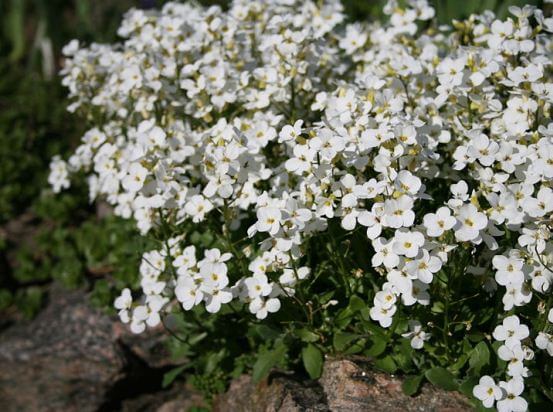

They put pots with cuttings in a well-lit place without direct sun access, the air temperature in such a room should be in the range from 18 to 22 degrees.
The shelter is removed daily, airing the young bushes and wiping off the emerging water condensation. With the appearance of the first roots, the leaves again become strong and elastic, and new, young shoots appear at the base of the cutting.
↑ Up,
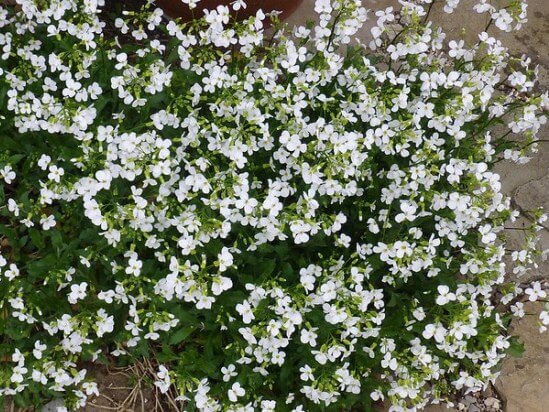

5.3 Propagation by air layering
One of the simplest breeding methods, which is carried out in late spring or early summer. The lateral shoots of arabis are tilted to the surface of the earth, pinned and slightly dug into the ground.
At the same time, the tip of the shoot should remain above the ground and should be pinched a little. The soil surface is always kept moist.
Subject to this agricultural technique, in a couple of three weeks, the first young leaves will appear from the dug-in part.
On each layer, several root systems can appear at once - according to the number of dug leaf nodes. When such a layer gets stronger, it is completely separated from the mother bush, divided into segments with separate roots and planted.
↑ Up,
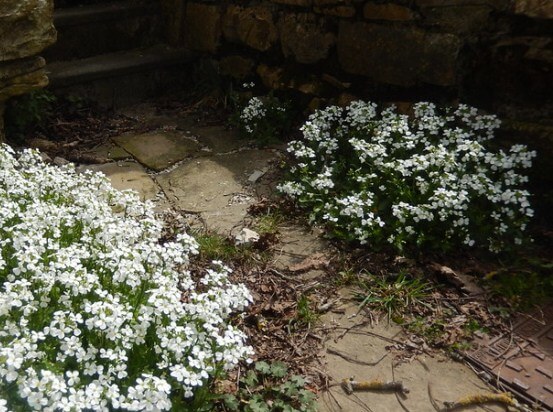

5.4 Division of mature plants
If necessary, in case of transplantation, you can divide the overgrown Arabis bushes into several parts.
Division is carried out after full flowering - in the second half of summer. The bushes are dug out of the ground and the roots are shaken off the remains of the soil.
The plants are cut into several divisions with a sharp knife, making sure that well-developed roots and leaves remain in each part obtained.
The wound surface is sprinkled with crushed charcoal blemish and the cuttings are seated in the desired place.
↑ Up,
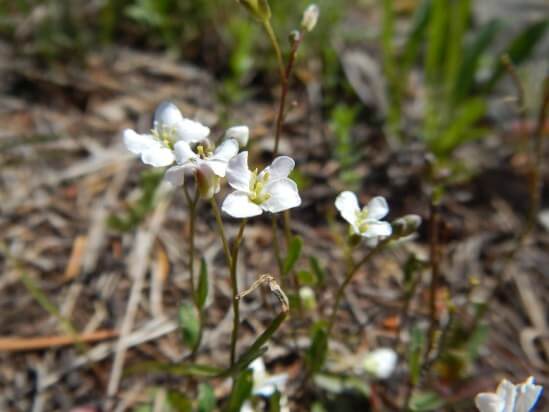

5.5 Diseases and pests
Bushes that receive competent care rarely suffer from diseases, most often fungi and viruses appear on weakened plants.
When a viral mosaic appears, the leaf blades acquire an uncharacteristic shade - the plants affected by the virus cannot be treated. Bushes are dug up and destroyed; such specimens cannot be sent to the compost pit either.The area where the infected plant was found is watered with boiling water, in which a lot of potassium permanganate was dissolved.
Downy mildew and rust sometimes appear.
Like most related plants, Arabis is subject to invasions by the cruciferous flea. From small rodents, plants can be annoyed by shrews.
↑ Up,


Seed preparation
If you want to independently prepare Arabis seeds and plant them next season, then it is best to start harvesting at the end of summer. It will be a big plus if the weather is dry and sunny on the day of harvesting.
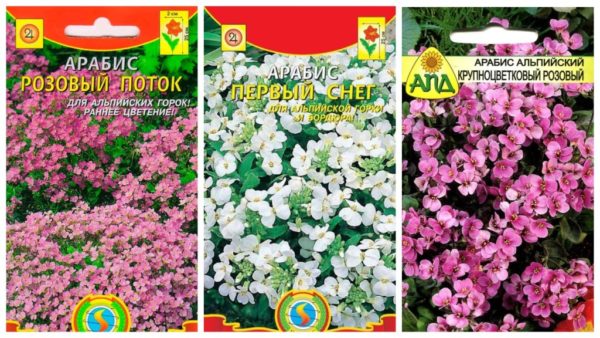

So, you need to cut off inflorescences with peduncles and leave them on sheets of paper at a temperature of 21-23 degrees in a place where the sun's rays do not penetrate.
Important!
Store seeds in a cool place in special bags.
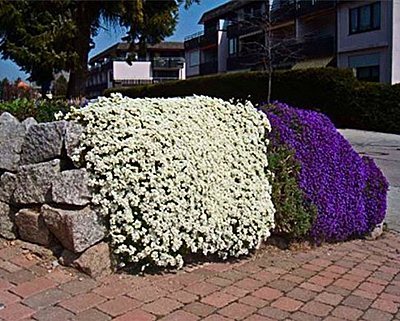

You may be interested in:
Arabis: planting and care in the open field If you have a plot outside the city, you do not often go there, but you want it to always look beautiful, with a lush ... Read more ...
Arabis care in a flower bed


Arabis long-term planting and care in the open field
It is not very difficult to care for Arabis on the site. It is necessary to water it, remove weeds, periodically cut it, apply fertilizers, loosen the soil, treat the plant from pests, if they appear. Rezuha can be grown in an area free from frequent rain, as it easily tolerates drought. But an excess of moisture has a detrimental effect on the development of these flowers, so you should not water them again.
Arabis must be constantly cleaned of weeds, otherwise they will drown out the delicate plant. When the seedlings get stronger, you can do it less carefully. To form a beautiful bush, the shoots are regularly pruned. The same applies to dried flowers, the pruning of which stimulates the formation of new peduncles.
Arabis seed growing
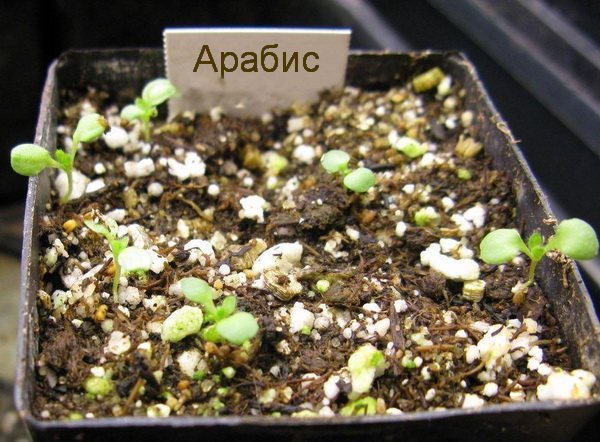

Arabis alpine growing from seeds when to plant
Growing arabis from seeds includes several stages:
1. Sowing seeds of rezuha... Seed material can be found in abundance at shops that sell varietal seeds. Special varieties can be purchased at flower shows. Sowing is carried out in the fall, in October, so that after winter, with the first warmth, see the shoots. But you can sow seeds in spring, in April. First, place the seed in a box with a previously prepared substrate containing sand with small stones and garden soil in a ratio of 1: 3. Planting depth - up to 5 mm, germination temperature - 20 ºC. To make the germination as high as possible, arrange a greenhouse from agrospan.


Arabis from seeds
2. Growing seedlings... The first shoots appear in 3-4 weeks. After that, the greenhouse is removed, the number and volume of watering is reduced, and the container with the seedlings is transferred to a lighter place. Seedling care is simple - timely moistening and loosening of the soil.
3. Picking... When the first true leaves appear, the Arabis seedlings dive. It must be separated into seedlings and planted at a distance of 30 cm or in separate glasses. But this is carried out only in two cases: if the plant is planned for individual planting, and not for growing with a carpet, and if you plan to sell seedlings individually.
4. Landing on a flower bed... Before this process, the seedlings must get used to the fresh air. To do this, for two weeks, they are taken out into the open for a short time every day. But at the same time, young organisms should not be allowed to find themselves in a draft, which is destructive for them. When the hardening process comes to an end, all the seedlings are placed in their place in the flowerbed and planted.
Planting and breeding
Arabis is planted in sunny or slightly shaded places. With insufficient lighting, the processes are stretched, fewer flowers are tied. With stagnant water, especially on heavy clay soils, the roots of arabis prey, so it is advisable to choose a place on a hill.
For the formation of dense flowering caps at the peak of flowering, the rezuha needs moisture-permeable, non-acidic soils, rich in nutrients, loose and breathable. However, even on a rather modest soil, the natives of rocks and sands will grow and form, delighting with flowering, but not so abundant and long-lasting.


When preparing the soil, the roots of perennial weeds are carefully selected. Coarse sand, crushed stone, dolomite flour or chalk are added to the planting holes. If moisture stagnates on the site after rains or melting snow, it is necessary to prepare drainage:
- Remove the top fertile layer 10-15 centimeters thick.
- Lay the broken brick.
- Sprinkle sand with a layer of 10-15 centimeters.
- Cover the top with nutritious soil with a layer of 20-25 centimeters.
Can be used for planting gaps and pockets between stones. Arabis bushes are planted at a distance of 30 centimeters from each other.
Sowing
Arabis is very easy and simple to cultivate from seed, which can be purchased in specialty stores, garden centers or flower shows. Sowing seeds can be worked out directly into open land before winter in October. You can also grow razuha through seedlings, in this case, the seeds should be sown in April.
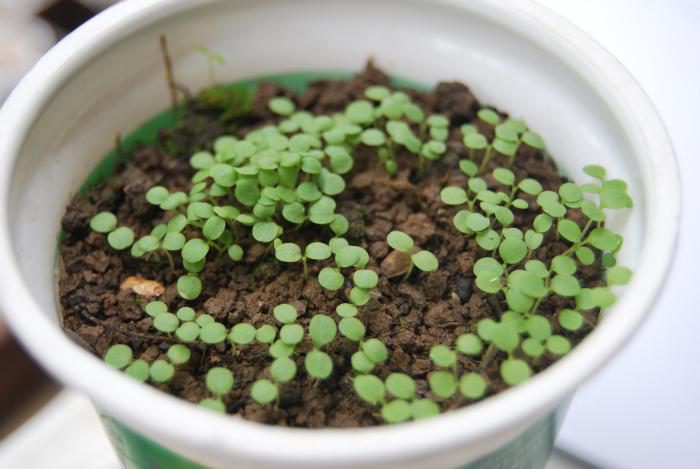

To do this, fill containers or crates with a soil mixture consisting of garden soil and small stones or sand (3: 1). The seeds must be buried in the substrate only half a centimeter, after which the container is placed in a place where the ambient temperature is about 20 degrees. To increase the germination rates of seeds, the container must be covered with a non-woven type of material, for example, agrospan.
After 3–3.5 weeks after the appearance of the seedlings, the shelter is removed, while watering must be reduced. Transfer the seedlings to a warm and well-lit room. Caring for these seedlings will not be difficult.
It only needs to be watered when required, and also systematically gently loosen the surface of the substrate.
Division of caste
In this way, exclusively terry and other decorative varieties of arabis reproduce. This makes it possible to preserve all the maternal properties of the plant.


Dividing the Arabis bush should be done only after they reach three or four years. Young bushes are not advised to share. It is necessary to carry out such a process at the end of summer or, and at the beginning of autumn at the end of the flowering period:
- To do this, it is important to carefully remove the bush from the ground and lightly shake the soil from the roots. Up to 20 young plants can be obtained from one mature bush.
- Using a sharp knife or pruning shears, the Arabis bush must be cut into the required number of divisions.
At the same time, it is important to immediately process all the cuts with crushed coal, so that they heal faster.
- In the prepared area, planting holes are made at a distance of about 35–40 centimeters from each other and delenki are planted, then watered abundantly.
Cuttings
This breeding method of Arabis is also used to grow ornamental crop varieties.


It is recommended to prepare planting material at the end of the flowering of arabis:
- As cuttings, you can use the leaves together with the heel, from which the roots are formed. To obtain such planting material, the sheet should not be cut off, but torn off, pulling slightly towards itself. So you will have a leaf with a piece of bark, which is called "heel".
- Apical shoots can also be used as cuttings. To extract them at the end of flowering, cut off the top of the shoot about 10 centimeters long. After that, all the lower leaves are removed.
- All cuttings are planted in a greenhouse or greenhouse at an angle, after which the beds are loosened and watered.
- It is advisable to cover the cuttings with a film or each seedling separately with plastic bottles.
- Daily care consists in maintaining the moisture level of the substrate, ventilating the cuttings, eliminating condensation.
- When the leaves become elastic again, the cuttings can be planted in a permanent place.
Combination with other colors
Despite the fact that Arabis itself is very beautiful, growers often supplement it with other plants. Thus, picturesque compositions are obtained that look quite impressive. So, rezuha goes well with the following plants:
- beetroot;
- shaved;
- bearded iris and other types;
- rejuvenated;
- tulips.
Perennial Arabis can even be used to decorate balconies. The main condition is that the balcony windows face south.


These were the basic rules for planting and caring for perennial arabis (including alpine), which will help you easily and without unnecessary hassle grow on your plots the same beautiful flowers as in the photo.
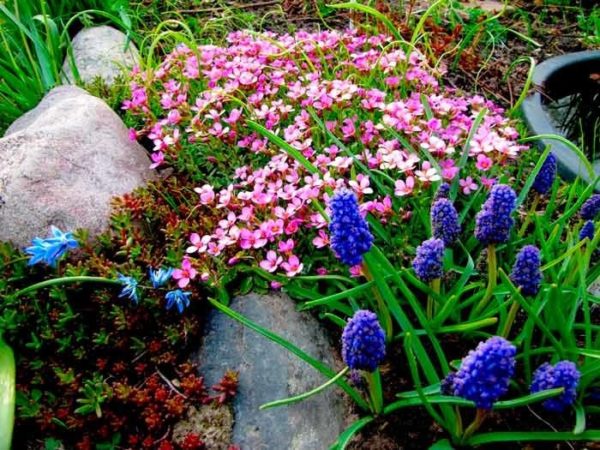

Varieties used in design
Arabis goes well with other plant species. But, in order to find the right one, it is worth examining its types and varieties.
Arabis Caucasian
The name suggests the conditions and homeland of growth: the Mediterranean, the Caucasus, Asia.
A low creeping plant, only about 30 cm long. Leaves are oblong, serrated, pubescent. Eight centimeter inflorescences consist of many small flowers. One of the oldest species grown in garden plots. It is over two hundred years old.


Caucasian rezuha grows very well, forming cushions up to 1 m in diameter. Wonderfully winters without shelter.
Subject to proper planting and care of the Caucasian perennial arabis, it blooms throughout the spring. The bred varieties will delight the owners with pink and white flowers. And Variegata will show its green and yellow leaves.
Arabis Snow Cloud
The main properties are included in the title. Snow clouds will fill all the cracks in the summer. Perennial Arabis Snow Cloud does not have any separate planting and care requirements. But unlike other varieties, it blooms throughout June. And, if there is a lot of it, in the photo from afar it seems that a snow storm has come.


Alpine Arabis
Stony soils are suitable for this type of rezuha, that is, it is best to grow it in a rock garden.


The basal heart-shaped leaves, collected in a rosette in the Alpine perennial Arabis, disappear in milky and lilac shades. In order to plant the finished seedlings, the bushes are divided. When creating a mixborder, plants are selected and planted nearby, requiring the same care.
Interesting!
Although this variety should be compact in its name, the flowers of its white and pink tones are striking in size, up to 20 mm.
If you are a fan of alpine slides or small curbs, be sure to start a rezuh to amaze your friends with the beauty of the site.
Growing conditions
Based on the natural conditions in the growing regions, it can be concluded that Arabis is unpretentious, undemanding to the composition of the soil, and tolerates temperature fluctuations well.
The plant feels most comfortable in sunny areas with loose soils without moisture stagnation. It is also possible to plant in light partial shade, but not next to large trees and tall spreading bushes.
If the soil is heavy, you can add a little sand and peat in equal proportions to give it a loose consistency.
